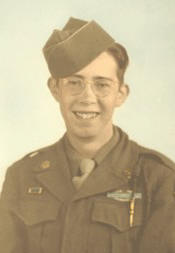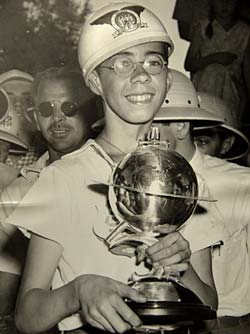WWII Events Page with Photos│Latest Happenings│6th Beach Battalion│Who am I?
The Sergeant John W. Gabersek Jr. Memorial Scholarship
Corporal Donald Matthews - 28th Infantry Division
110th Infantry Regiment - I Company - Rifleman

www.soldiersandsailors.us
Home│2009
Trip to France│Other
WWII Veterans I Know│The
WWII Memorial│The
Home Front│Contact
Me
WWII Events Page with Photos│Latest
Happenings│6th
Beach Battalion│Who
am I?
The Sergeant
John W. Gabersek Jr. Memorial Scholarship
Corporal
Donald Matthews - 28th
Infantry Division
110th Infantry Regiment - I Company - Rifleman

Arriving
in the European theater in January of 1945, Don found himself
thrown into the Battle of the Bulge, a baptism of fire by ice and snow.
Don and I became immediate friends a couple of years ago after he and I
exchanged emails. Unbelievable some would say because Don
actually served with the same division, same regiment, and same company
as the reenacting unit that I am a member of.
Don is a Bronze Star recipient, and although I will not go into the
details regarding the circumstances, his courage and dedication to
serving our nation stands as testimony to all the boys sent overseas
who returned as men.

Don was on a 3 day pass in France when the war ended,
no doubt one of the luckiest guys in the army.....
At
age 15 in 1941, Don won the Albany Area Soap Box Derby
Read
the entire story by clicking here.
The History of the 28th Division in WWII
On Feb. 17, 1941, the 28th Division
Pennsylvania National Guard was ordered into federal service for one
year of active duty. The Japanese attack on Pearl Harbor on Dec.
7, 1941 led soldiers of the 28th to remain on active for the duration
of the war. Having conducted specialized combat training in everything
from offensive maneuvers in mountainous terrain to amphibious warfare,
the Division's intensive training agenda culminated in its deployment
to England on Oct. 8, 1943.
After another 10 months of training in England and Wales, the first
elements of the Division entered combat on July 22, 1944, landing on
the beaches of Normandy. From Normandy, the 28th advanced across western France, finding itself
in the thick of hedgerow fighting through towns such as Percy, Montbray, Montguoray, Gathemo, and St. Sever de Calvados by the end of
July 1944. The fury of assaults
launched by the 28th Infantry Division led the German Army to bestow
the Keystone soldiers with the title "Bloody Bucket" Division.
In a movement north toward the Seine in late August, the Division
succeeded in trapping the remnant of the German 7th Army
through Vorneuil, Breteuil, Damville, Conches, Le Neubourg, and Elbeuf
before
entering Paris to join in its liberation.
The famous photographs of American troops before the Arc de Triomphe,
marching in battle parade down the Champs Elysees, shows the men of 1st
Battalion, 110th Infantry Regiment, 28th Infantry Division. With no
time to rest, the Division moved on to fight some of the most bloody
battles of the War the day following the parade.
The 28th continued to advance through the Forest of Compeigne, La Fere,
St. Quentin, Laon, Rethel, Sedan, Mezieres, Bouillon and eventually
across the Meuse River into Belgium. The Keystone soldiers averaged 17
miles a day against the resistance of German "battle
groups." The city of Arlon, Belgium, fell to a task force as the
Division fanned out into Luxembourg in early September. On
September 11, 1944, the 28th claimed the distinction of being the first
American unit to enter Germany.
After hammering away in assaults which destroyed or captured 153
pillboxes and bunkers, the Division moved north toward the Siegfried
Line, clearing the Monschau Forest of German forces. After a brief
respite, the Keystone soldiers made another move northward to the
Huertgen Forest in late September. Attacks in the forest began November
2, 1944. The 28th Infantry Division stormed into Vossenack, Kommerscheidt and Schmidt amid savage fighting and heavy
losses.
By November 10, the 28th began to move south, where it held a 25-mile
sector of the front line along the Our River. It was against this thinly
fortified division line that the Germans unleashed the full force of
their winter Ardennes "blitzkrieg" offensive.
Five Axis divisions stormed across the Our River the first day,
followed by four more in the next few days. Overwhelmed by the weight
of enemy armor and personnel, the Division maintained its defense of
this sector long enough to throw Von Runstedt's assault off
schedule. With allied forces able to a move in to counterattack, the
"Battle of the Bulge" ensued, inflicting heavy losses on the enemy
forces.
Clervaux and St. Vith December 1944
Having sustained a devastating 15,000 casualties, the 28th withdrew to
refortify. But within three weeks, the Division was back in action. By
January 1945, Division soldiers had moved south where they served with
the French First Army in the
reduction of the "Colmar Pocket. The 109th Infantry Regiment was
awarded the French Croix de Guerre for its action which helped lead to
the liberation of Colmar, the last major French city in German hands.
By February 23, 1945, the Division returned north to the American First
Army. The 28th was in position along the Olef River when an attack was
launched on March 6, 1945, carrying the Division to the Ahr River.
Schleiden, Germund, Kall, Sotenich, Sistig and Blankenheim all fell in
a raid advance. By early April, the Division moved west
of the Rhine and took up occupation duties in the area north of Aachen
along the Holland-German border. Permanent occupation came two weeks
later at the Saurland and Rhonish areas. In early July 1945, the 28th
began its redeployment to the U.S.
The Division was deactivated on December 13, 1945. Five campaign streamers -
Normandy, Northern France, Ardennes-Alsace, Rhineland, and Central Europe - were
earned during World War II, in addition to the Croix de Guerre.
Nearly 6 decades later, World War Two enthusiasts and historians formed
companies of the 110th Infantry Regiment of the 28th Infantry Division.
The group formed to
recreate, educate, and enlighten the public to the events previously
recorded above. It is our honor to pay tribute in a small way to
those who fought so valiantly to preserve freedom and liberty for
generations to come. Based in the Western Pennsylvania and
Eastern Ohio the group boasts a membership of nearly 30 men. Some are
even active duty members of our current Armed Forces serving the
cause of liberty and freedom in our time. May all of those who so
proudly wore and wear the flag of the United States, carry with them
the torch of freedom for millions of Patriots across a thankful nation.
Roll On!
http://groups.yahoo.com/group/thebloodybucket/ <<< === For Veterans, Friends, and Reenactors
http://groups.yahoo.com/group/rollon28th/ <<< === Honors our Veterans
An all inclusive website for the 28th Division Reenactors